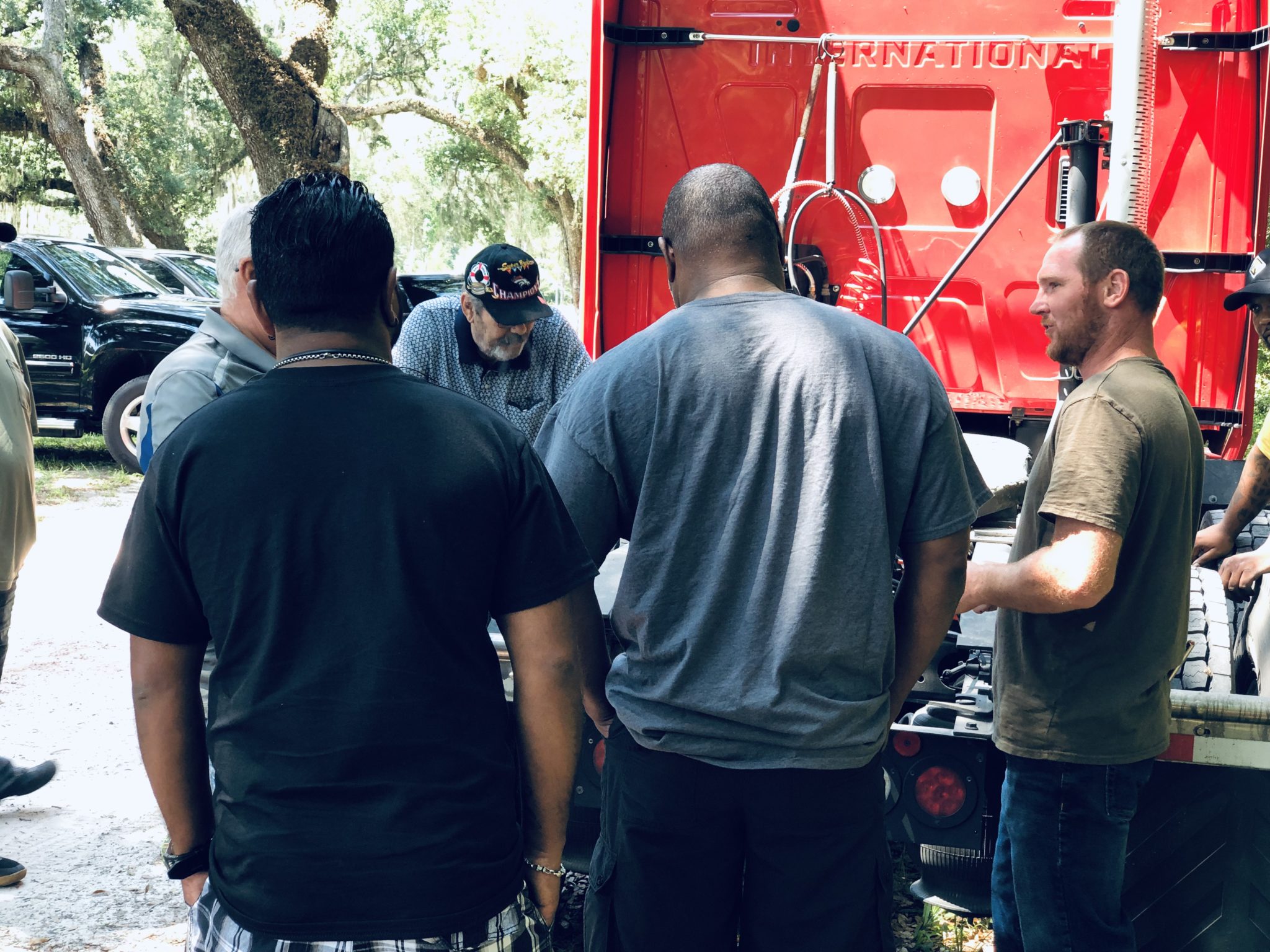There’s no escaping the fact that the turnover rate in the trucking industry is shameful.
Truck drivers are constantly leaving one trucking company for another, and it’s becoming a very rare occurrence to talk to a driver who has been loyal and dedicated to his or her company for years.
Before we get into the reasons why, it’s important to understand what exactly the driver turnover rate is, and how it compares to other industries.

What’s the Driver Turnover Rate?
According to the American Trucking Association’s Trucking Activity Report, the annual truck driver turnover rate is 94%.
Let that sink in for a second… that means that your average trucking company is going to lose nearly ALL of their drivers in a year. That’s insane! And in reality, many trucking companies experience over 100% turnover rate, which means they’re losing all of their drivers in less than a year. It’s a constant churn.

Other industries, like construction, have a 5% turnover rate. Education and health services are at under 3%. And off in the corner of the universe is the trucking industry at a staggering 94%!
We’re lucky enough here at Freight X to have a lower turnover rate than the industry average, but still, it’s clear that the majority of drivers either aren’t happy, or they are constantly looking for something better.
Here are the top 5 reasons we’ve found truck drivers to leave their current trucking company for a new one:
- Drivers aren’t happy with their dispatchers.
- Drivers are looking for higher pay somewhere else.
- Drivers are looking to run more miles.
- Drivers aren’t getting enough home time.
- Operations isn’t following through with what was promised during recruitment.
While some of these reasons are 100% valid, there are some potential traps to look out for. For example, what sounds like higher pay in an advertisement doesn’t always mean higher pay. Let’s get into it.
1. Drivers aren’t happy with their dispatchers.
While pay is obviously a very important factor, it’s not everything. In a safety class I recently attended, the presenter mentioned that whenever surveys are done among truck drivers, the No. 1 reason drivers leave for another company isn’t the money – it’s that they’re not happy with their dispatchers.
When a driver doesn’t have support from the office staff, especially their dispatcher, it can feel like they’re all alone on the road.
Driving a truck can be lonely as it is, and when you’re missing the support you need from your dispatcher and office team, it can be enough to make you pack your bags for a new employer.
Loneliness can lead to serious health conditions like cancer, type 2 diabetes, heart disease, and even impaired immune system function. In fact, loneliness is as detrimental to your health as obesity or smoking (Journal of Aging Life Care). While many drivers find solitude in driving, and some even see it as therapeutic, others can really suffer from being disconnected from others.
That’s why having great support and communication from your team, especially your dispatcher, is so critical. And that’s why we take it very seriously here at Freight X.
While we’re not perfect, we feel like we’ve built an incredible team that’s supportive and is constantly in communication with drivers. And that’s the way it should be!

2. Drivers are looking for higher pay somewhere else.
The most publicized reason for driver turnover is pay. When a company advertisers higher pay, many drivers are quick to take them up on the offer without a second thought.
And when compensation is high and competitive, the trucking industry as a whole experiences less turnover. According to the American Trucking Association (ATA), the driver turnover rate for large truckload carriers dropped to 78 percent in the last quarter of 2018, and JOC says higher truck driver pay is the reason behind it.
We get it – while pay isn’t everything, it is one of the most important factors when evaluating your job. However, it’s important to understand the two potential traps behind an offer for higher pay:
- Higher pay, but for fewer miles
- Higher percentage for owner operators, but with a catch
Higher pay for fewer miles
I can’t tell you how many times I’ve heard drivers talk about how yes, they’re making more per mile at their current company, but they don’t get even 1,000 miles in a week!
Higher pay only means something if you’re actually out there running freight. If you’re only making $400 paychecks, who cares that you’re making an extra cent or two per mile?!
We run our drivers as much as they want, with the average mileage per week being over 3,500 miles. The drivers who make the most money are the ones who are out for 2 weeks and come home for a few days to relax.
The longer you’re on the road, the more dough you can bring home.
Higher percentage for owner ops, but there’s a catch
For our owner operators out there, the percentage of the load is key. However, there are two ways a company can do this:
- Pay you a percentage of the total load
- Pay you a percentage of the line haul and another percentage of the fuel
This distinction is really important because it can be deceiving.
For example, some companies advertise a whopping 75% for owner operators. However, a number that high is going to be 75% of the total load – including fuel.
The way we structure our program is 70% of the line haul, and 100% of the fuel. We think this is a much more fair approach for the owner op, because you’re the one paying for the fuel!
As fuel goes up and down in price, fuel surcharges also fluctuate – drivers should get 100% of that no matter what.

The only time that a higher percentage of the total load will work in your favor is if you’re running a load that’s very few miles with a very high rate per mile.
Our model, or 70% of the line haul and 100% of the fuel, works in your favor in every other circumstance – especially if you’re in a situation where you’re making a low amount per mile and have to travel a long distance.
Owner Operator Percentages Examples
We’re getting in the weeds here, but stick with us.
Example 1: 100-mile run at $5 per mile
Let’s say we have a 100-mile run paying $5 per mile. At current fuel rates, that would be about $37 Fuel Surcharge (FSC), and $463 line haul.
Using our model, the driver would be paid $324.10 of the line haul and $37 in fuel, making his total pay $361.10, or 72.22% of the total load.
In this example where you’re making a lot per mile and are going a short distance, the 75% of the total load would actually work out better for you, because you would have made $13.90 more. But, $13 isn’t really a big difference.
Example 2: 500-mile run at $1 per mile
Now, let’s say you have a 500-mile run, and this time, it’s out of a bad area. It’s only paying $1 per mile. At current fuel rates, this would be $185 in FSC, and $315 in line haul. Using our model, a driver would make $220.50 in line haul and $185 in FSC, making his total pay $405.50, or 81.1% of the total load.
The lower rate and longer miles made the FSC account for a larger portion of the overall rate.
If you were at a straight 75% of the total load, the pay would still be $375, or $30.50 less. That’s a bigger difference in the amount of money the driver will bring home.
Our model helps the driver when the rate is low and the miles are long – which is exactly when he needs help to cover fuel! And when the rate per mile is high and the miles are short, the rate helps make up for the fuel you burn.
3. Drivers are looking to run more miles.
Like we were just saying, making more per mile means nothing if you’re not being given any miles.
We actually have seen this happen to drivers in a lease purchase contract – when they get close to finally paying off the truck, the company stops giving them loads, and they get burned!
Read more: 7 Ways to Avoid Getting Screwed Over on a Lease Purchase Agreement
If you’re not making any money at your current company due to lack of milage, you need to look for a different trucking company that will keep your schedule as full as you can handle!
Look for a company that rewards dispatchers for having higher mileage on its trucks – that’s a sure way to know that everyone is working towards the same goal. Which is to make money, of course!

4. Drivers aren’t getting enough home time.
While more mileage equals higher pay, there’s a balance. Not having consistent home time, or any home time at all, is the quickest way to get burnt out.
It’s no wonder drivers start looking for a new trucking company when they’re never able to see their children.
Striking a work-life balance is difficult in trucking, but setting expectations with your employer from the beginning is important.
We’ve had drivers request to be home every weekend, and we accommodate that. We have other drivers who prefer to knock out two weeks of driving, then come home and rest with their families for 4 or 5 days. That’s a great way to maximize your earnings while maintaining a work-life balance.
No matter what your preference is for having home time, make sure you discuss this with your employer before coming on board.
Speaking of which….
5. Operations isn’t following through with what was promised during recruitment.
When you’re told that you’ll be given 3,000 miles per week and will be home every other week and it doesn’t happen… we wouldn’t blame you for jumping ship.
Logistics is extremely complicated and fragile, and anyone in trucking knows that nothing ever goes as planned. Having a bad week is basically guaranteed.
Your truck breaks down, the weather sucks, the shipper had a delay, you ran into major traffic and missed your delivery window… it all happens. But it’s important to understand the difference between typical trucking and lack of follow-through from operations.
If a pattern emerges and a length of time goes by that none of the promises made upon hire are being fulfilled, it’s time to have a talk with operations. At that point, you can consider looking for a new trucking company, or perhaps it was all a misunderstanding.
Opening up the lines of communication is extremely important, especially in an industry with such a high turnover rate.

Look for a Reputable, Family-Oriented Trucking Company
There are other reasons drivers jump ship, such as looking for better equipment, but at the end of the day, you want to work for a reputable, honest, and family-oriented trucking company.
There are so many “big dogs” out there that could care less about each individual driver. To them, you’re just a number, and that can cause many of the issues we outlined.
By asking important questions upon hire and making sure everyone is on the same page, you can save yourself a lot of heartache.
Conclusion
Working for the same trucking company not only makes your life less complicated, but you’ll finally be settled enough to develop relationships with your team. And that’s part of what makes trucking such a wonderful community.
While our industry has a high turnover rate, I’m hopeful that with more education and time spent looking at why, we can start to lower it.



